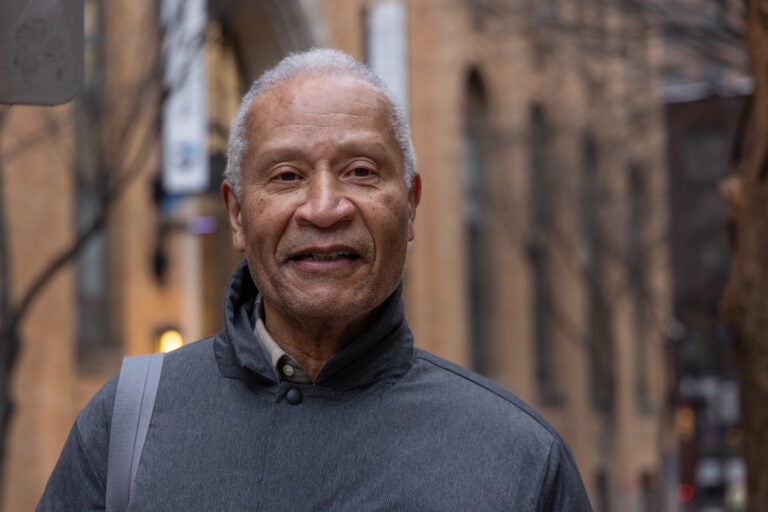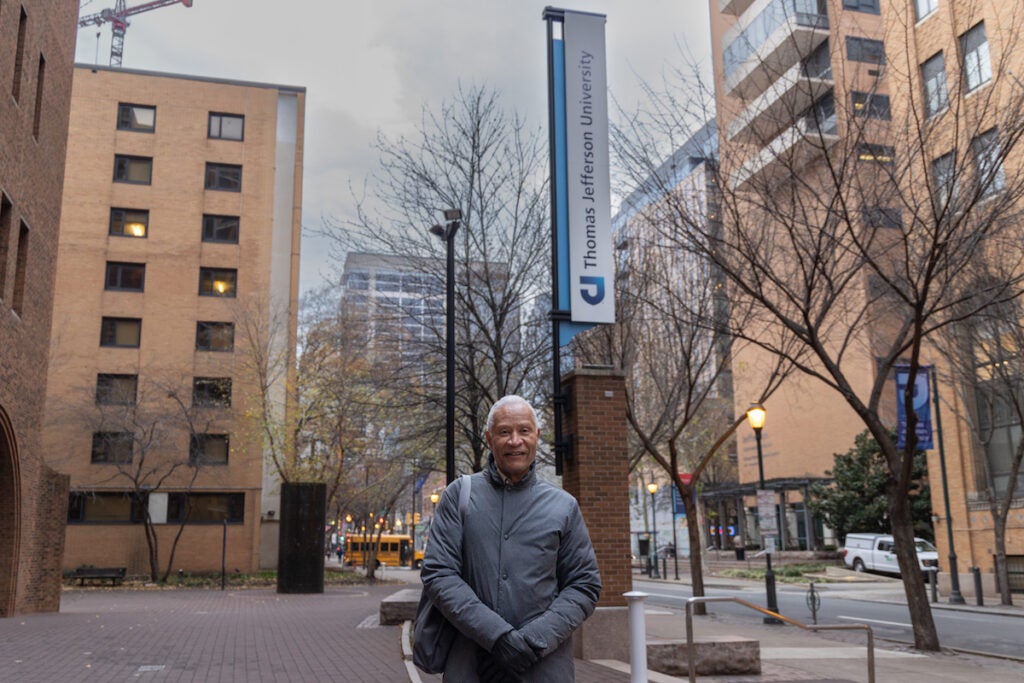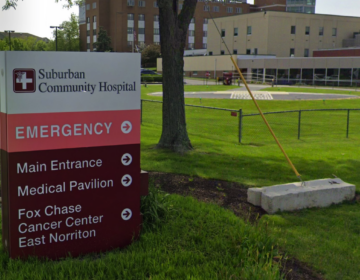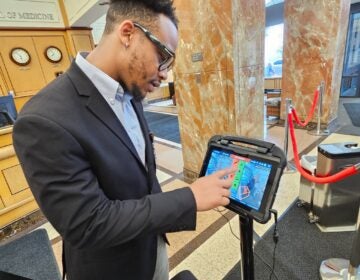Meet the paid medical actors at Jefferson Health trying to unionize amid budget tightening
There’s pressure from a new union inside Jefferson Health for higher worker wages during a period where the umbrella organization is trying to narrow its operating losses.
Listen 1:58
Wil Durant, a standardized patient, after work at Jefferson University. (Kimberly Paynter/WHYY)
From Philly and the Pa. suburbs to South Jersey and Delaware, what would you like WHYY News to cover? Let us know!
Within five minutes of speaking with Wil Durant on a recent zoom call, the senior citizen promptly offered his pronouns.
“With my SP training, pronouns are he and him,” Durant said, using the shorthand for his retirement gig — being a standardized patient.
Durant, whose first name is Wilbert, hails from Wilmington, N.C., but moved after college to Philadelphia — about 50 years ago.
His friends always ask him what exactly a standardized patient does at work.
“I tell them I work with medical students. I present a case history to them giving them the opportunity to interview a patient about a condition,” Durant said about what he’s been doing for the past eight years. “So I pretend to be a patient. In some cases I’m just a body model allowing them to conduct a physical examination.”
In exchange for being a patient actor roughly three days a week, Durant earns about $20 an hour from Thomas Jefferson University under the Jefferson Health umbrella.
That’s before Philadelphia’s city wage tax, state, and federal taxes are taken out of his paycheck.
Durant said he earns the lowest rate per hour by several dollars compared to the competition. The University of Pennsylvania which pays $22 an hour and Temple University offers $25 an hour, but he still “takes as much work as I can get” after retiring from decades working with incarcerated individuals as his primary career path.
Unlike some side gigs, Durant is not a small business owner or freelancer with Jefferson Health, he’s a regular W-2 employee, he said.
But he’s not guaranteed any work hours, as per his contract, he said.

Instead, Philly standardized patient union organizers — like Durant — say they’d prefer to see base pay closer to $30 an hour in exchange for their expertise which includes memorization, acting and assessment of a students’ skills, often for hours on end.
More of his fellow standardized patients told WHYY News that’s the same deal with their 138 colleagues at Thomas Jefferson University’s Rector Clinical Skills & Simulation Center, who help train students attending Thomas Jefferson University’s Sidney Kimmel Medical College and the Jefferson College of Nursing, have.
On Monday, the National Labor Relations Board, the federal agency that oversees labor unionization efforts and often disputes between employees and employers, was scheduled to hold its first meeting between Jefferson Health and OPIEU Local 32 attorneys to begin the process of a union election expected to take place in the coming weeks, records obtained by WHYY News show.
That’s because Jefferson Health declined to voluntarily recognize the union in mid-November, the organization confirmed. It’s not unusual for employers to push for a secret ballot election either, but it’s generally expected, said Todd Vachon, assistant professor of Labor Studies and Employment Relations at Rutgers University, who does not represent either side in this case.
What’s also pretty typical is that employers are more likely to make promises to dissuade workers from voting yes to create a union, he said.
“That period before the election is the time when employers can engage in scare tactics and pick-off some people from supporting the union,” he said. “So the number on the petition is actually often lower than those that vote yes in the election.”
And that’s just what workers claim Jefferson Health is doing right now, circulating flyers for meetings with management to discuss the work environment, offering a soft temporary pay bump of several dollars per hour, and various other tactics.
“We’ve heard a lot about Starbucks with the captive audience meetings, the threats of not hiring people or closing facilities or promises of giving more benefits to people that didn’t join the union,” Vachon said. “All those things are technically illegal [according to federal labor law], but there’s really no strong punishment for them. So a lot of employers just take advantage of that weak labor law and use that period [before the union election] to scare workers away from voting.”
But in recent years what has changed is the relationship between workers and employers, especially since the COVID-19 pandemic began in March 2020, Vachon said. For example, unionization in health care after a tumultuous time in the industry is a trend to watch.
“In the current economy, [employers have] kind of been a little bit less effective than they have been historically because workers just feel a little bit more empowered with the tight labor market,” he said. “People have [raised] serious concerns about health and safety issues since COVID-19, and are willing to take greater risks than say four or five years ago.”
Jefferson Health is also just one major institution that hires these medical actors as a requirement of its health care education training. There are roughly hundreds of paid actors who may move forward with their own unionization effort at other medical schools, organizers said.
The OPIEU Local 32 and standardized patient union organizers claim that the paid actors have not received a base pay increase since 2008. They added that the university’s scheduling system is “erratic, frequently leading to weeks or even months without work and pay.”
The workers say they are concerned about safety precautions, and their own health and safety — but also that of students they work most closely with on any given day. Some complained that there was inadequate supervision of students during examinations, particularly more invasive ones. There were also concerns about security breaches where unauthorized individuals have entered the Center City building during work hours.
Jefferson Health officials declined a news interview request for this story. Nor did the health care system respond to some of WHYY News’ specific written questions in an attempt to fact check the union’s various claims.
In a submitted statement, Jefferson Health officials said they respect the rights of workers to unionize or not. And that the National Labor Relations Board is expected to hold an election soon using the secret ballot system. The organization said that safety and security is a top priority for both the actors and students, and its security protocols are regularly reviewed.
When Philadelphia musician Andy Molholt isn’t rocking out with one of his bands, he works as a standardized patient.
“Most people in the public don’t even know that standardized patients exist,” Molholt said. “It’s an odd job. But it’s a super undervalued one.”
Molholt said he stays in the business and even has taken on more responsibility within Jefferson Health, because it “feels good to be working in a sector that’s potentially going to be helping real world people.”
But he’s concerned that there’s been some aspects of the program that “aren’t quite up to snuff as they used to be and no one’s really minding the shop. That kind of freaks me out. [Jefferson Health] would rather penny pinch here and there, so they can stay under budget [rather] than just pay standardized patients what they’re worth.”
Philly native and serial union organizer Mary Thomas, who says she doesn’t feel like a senior citizen but is technically old enough to be one, says there’s no typical day and that’s why there’s a lack of stability, which for her means a union makes the most sense.
“You can be ‘having a stroke’ one day. You can have pneumonia the next day,” Thomas said. “Our schedule is not set.”
In part, it appears there’s regular scheduling because there’s a talent pool and casting calls for specific clinical training rotations.
Her colleague Kimya Imani Jackson works as a standardized patient because she moonlights as a dance artist, but also has a PhD in health care science and has done research on health disparities.
“I don’t think we’re asking for the sky and the moon,” Jackson said. “Pretty basic health, safety, and compensation to do the very best at our jobs. All of us are committed to the work. We have quite a few teachers. We have retired nurses. We have business owners. The whole gamut, ranging from 20s to 80s.”

But Jefferson Health has told her that there are financial “issues at both the hospital and the university” when she inquired about pay raises.
That’s also what Jefferson Health has been telling its bondholders too. The organization laid off several hundred workers over the summer — which is a fraction of its tens of thousands of employees — after an acquisition spree in recent years.
Especially as federal COVID-19 pandemic aid funding rolls off the balance sheets of hospitals nationwide, some experts argue that the old financial models won’t work anymore, even as patients return for health care in person.
The Hospital and Healthsystem Association of Pennsylvania, an advocacy organization for health care institutions statewide, commissioned some research released about a year ago detailing challenges in the market in terms of profitability.
In general, 2022 was more financially draining than during the first two years of the pandemic because providers were tackling staffing shortages, higher labor costs, supply chain issues, inflation, rising interest rates on debt and global markets in flux, according to the report.
“This sentiment was overwhelmingly conveyed in interviews with leaders representing 10 hospital and health systems across Pennsylvania. Many of these challenges are not merely transitory but likely represent a new normal,” according to the report.
In general, Jefferson Health saw a $78.5 million loss from operations for the fiscal year ending June 30, according to financial documents shared with bondholders. That’s an improvement from $125.8 million in the red in June 2022.
By Sept. 30, Jefferson Health was $48 million dollars in the red for the quarter, which shows a narrowing loss. That’s compared to $84 million dollars in losses during the quarter ending September 2022.
Operating revenue was up nearly 6%, but expenses were also nearly 4% higher at Jefferson Health — or roughly $125 million and about $90 million respectively — as of Sept. 30.
One major project in the works is a $762 million dollar Honickman Center at 11th and Chestnut Streets in Center City — about $66 million has been spent during the third quarter this year.
The next bond report which would have more information about Jefferson Health’s financials is expected by the end of the year.
On an individual level, Jackson says she sees her work as indispensable as a standardized patient because so much of a doctor’s diagnosis is “based on the conversation” and she wants to help medical professionals be educated enough to catch major diseases — like the health condition of her mother which was misdiagnosed.
“If you’re not hearing people, not respecting people, then information is missed. People don’t come back,” she said. “It not only impacts them, but impacts the communities they’re a part of and choices [patients are] able to make.”
Jackson says she worries about being replaced by artificial intelligence and has heard about standardized patient avatars that “just haven’t gotten good enough yet.”
Jefferson Health officials said in a statement that they don’t expect to replace standardized patients with technology such as artificial intelligence.
The standardized patient union election should be held in the coming weeks.
If the effort is successful, Durant, the senior citizen who says he’s been “generally pretty happy” hopes to get a lunch break, more consistent scheduling, and to tuck away more money for his own health care.
“I’d put it away for senior care, you know, for emergencies and the kind of health care challenges that might be ahead for me, like assisted living or whatever. I think I need to be better prepared,” he said. “I’m just kind of skating by and I’m OK. I’m getting by, but like most of America, a check or two from living in a refrigerator box. I have a little bit of a cushion but no trust fund.”
WHYY is your source for fact-based, in-depth journalism and information. As a nonprofit organization, we rely on financial support from readers like you. Please give today.








